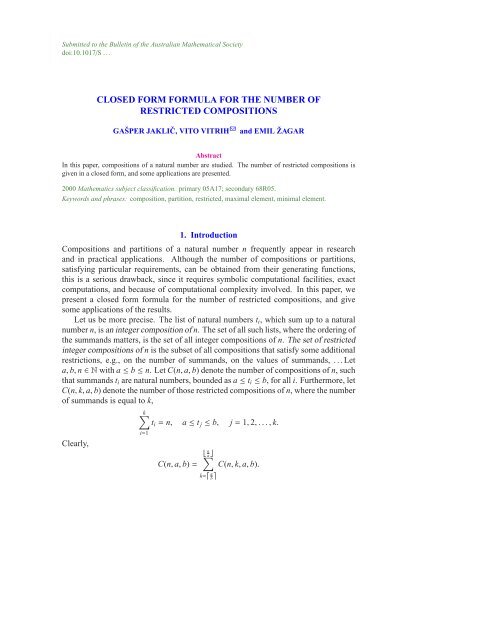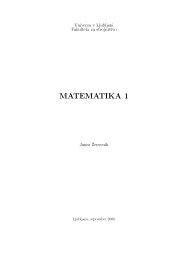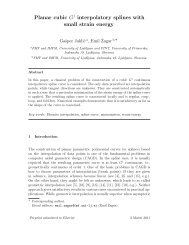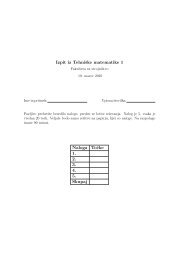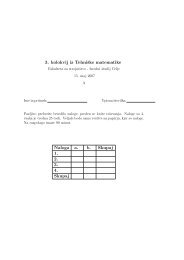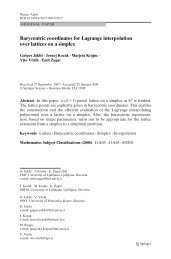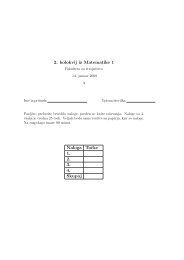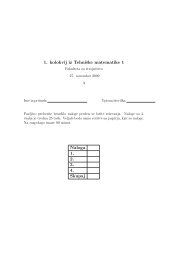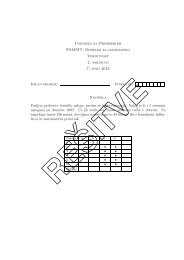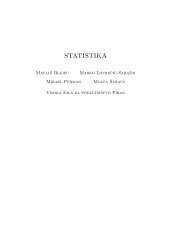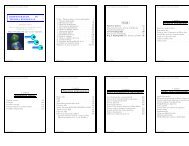closed form formula for the number of restricted compositions
closed form formula for the number of restricted compositions
closed form formula for the number of restricted compositions
Create successful ePaper yourself
Turn your PDF publications into a flip-book with our unique Google optimized e-Paper software.
Submitted to <strong>the</strong> Bulletin <strong>of</strong> <strong>the</strong> Australian Ma<strong>the</strong>matical Societydoi:10.1017/S . . .CLOSED FORM FORMULA FOR THE NUMBER OFRESTRICTED COMPOSITIONSGAŠPER JAKLIČ, VITO VITRIH □∨ and EMIL ŽAGARAbstractIn this paper, <strong>compositions</strong> <strong>of</strong> a natural <strong>number</strong> are studied. The <strong>number</strong> <strong>of</strong> <strong>restricted</strong> <strong>compositions</strong> isgiven in a <strong>closed</strong> <strong><strong>for</strong>m</strong>, and some applications are presented.2000 Ma<strong>the</strong>matics subject classification. primary 05A17; secondary 68R05.Keywords and phrases: composition, partition, <strong>restricted</strong>, maximal element, minimal element.1. IntroductionCompositions and partitions <strong>of</strong> a natural <strong>number</strong> n frequently appear in researchand in practical applications. Although <strong>the</strong> <strong>number</strong> <strong>of</strong> <strong>compositions</strong> or partitions,satisfying particular requirements, can be obtained from <strong>the</strong>ir generating functions,this is a serious drawback, since it requires symbolic computational facilities, exactcomputations, and because <strong>of</strong> computational complexity involved. In this paper, wepresent a <strong>closed</strong> <strong><strong>for</strong>m</strong> <strong><strong>for</strong>m</strong>ula <strong>for</strong> <strong>the</strong> <strong>number</strong> <strong>of</strong> <strong>restricted</strong> <strong>compositions</strong>, and givesome applications <strong>of</strong> <strong>the</strong> results.Let us be more precise. The list <strong>of</strong> natural <strong>number</strong>s t i , which sum up to a natural<strong>number</strong> n, is an integer composition <strong>of</strong> n. The set <strong>of</strong> all such lists, where <strong>the</strong> ordering <strong>of</strong><strong>the</strong> summands matters, is <strong>the</strong> set <strong>of</strong> all integer <strong>compositions</strong> <strong>of</strong> n. The set <strong>of</strong> <strong>restricted</strong>integer <strong>compositions</strong> <strong>of</strong> n is <strong>the</strong> subset <strong>of</strong> all <strong>compositions</strong> that satisfy some additionalrestrictions, e.g., on <strong>the</strong> <strong>number</strong> <strong>of</strong> summands, on <strong>the</strong> values <strong>of</strong> summands, . . . Leta, b, n∈N with a≤b≤n. Let C(n, a, b) denote <strong>the</strong> <strong>number</strong> <strong>of</strong> <strong>compositions</strong> <strong>of</strong> n, suchthat summands t i are natural <strong>number</strong>s, bounded as a≤t i ≤ b, <strong>for</strong> all i. Fur<strong>the</strong>rmore, letC(n, k, a, b) denote <strong>the</strong> <strong>number</strong> <strong>of</strong> those <strong>restricted</strong> <strong>compositions</strong> <strong>of</strong> n, where <strong>the</strong> <strong>number</strong><strong>of</strong> summands is equal to k,k∑t i = n, a≤t j ≤ b, j=1, 2,...,k.Clearly,i=1C(n, a, b)=⌊ n a⌋ ∑k=⌈ n b⌉C(n, k, a, b).
8 G. Jaklič, V. Vitrih and E. Žagarand⎧⎪⎨β k =∑⎪⎩k(n−k)j=0where˜P(n, k, b) := ∑ kl=1P(n,l, 1, b).0, k is even,( k˜P( 2 )πj, k, n−k) sin2n +π n j , k is odd, ,5. AcknowledgementWe would like to thank Pr<strong>of</strong>. Marko Petkovšek and Pr<strong>of</strong>. Herbert Wilf <strong>for</strong> <strong>the</strong>irvaluable suggestions.References[1] Rida T. Farouki. Pythagorean-hodograph curves: algebra and geometry inseparable, Geometryand Computing, Volume 1 (Springer, Berlin, 2008).[2] Philippe Flajolet and Robert Sedgewick. Analytic combinatorics (Cambridge University Press,Cambridge, 2009).[3] Gašper Jaklič, Jernej Kozak, Marjeta Krajnc, Vito Vitrih, and Emil Žagar. ‘Geometric Lagrangeinterpolation by planar cubic Pythagorean-hodograph curves’. Comput. Aided Geom. Design 25 (9)(2008), 720–728.[4] Gašper Jaklič, Jernej Kozak, Marjeta Krajnc, and Emil Žagar. ‘On geometric interpolation byplanar parametric polynomial curves’. Math. Comp. 76 (260) (2007), 1981–1993.[5] Gašper Jaklič, Jernej Kozak, Marjeta Krajnc, and Emil Žagar. ‘On geometric interpolation <strong>of</strong>circle-like curves’. Comput. Aided Geom. Design 24 (5) (2007), 241–251.[6] N. J. A. Sloan. The Online Encyclopedia <strong>of</strong> Integer Sequences, http://www.research.att.com/∼njas/sequences (2008).Gašper Jaklič, FMF and IMFM, University <strong>of</strong> Ljubljana, Jadranska 19, Ljubljana,Slovenia,PINT, University <strong>of</strong> Primorska, Muzejski trg 2, Koper, Sloveniae-mail: gasper.jaklic@fmf.uni-lj.siVito Vitrih, PINT, University <strong>of</strong> Primorska, Muzejski trg 2, Koper, Sloveniae-mail: vito.vitrih@upr.siEmil Žagar, FMF and IMFM, University <strong>of</strong> Ljubljana, Jadranska 19, Ljubljana,Sloveniae-mail: emil.zagar@fmf.uni-lj.si


